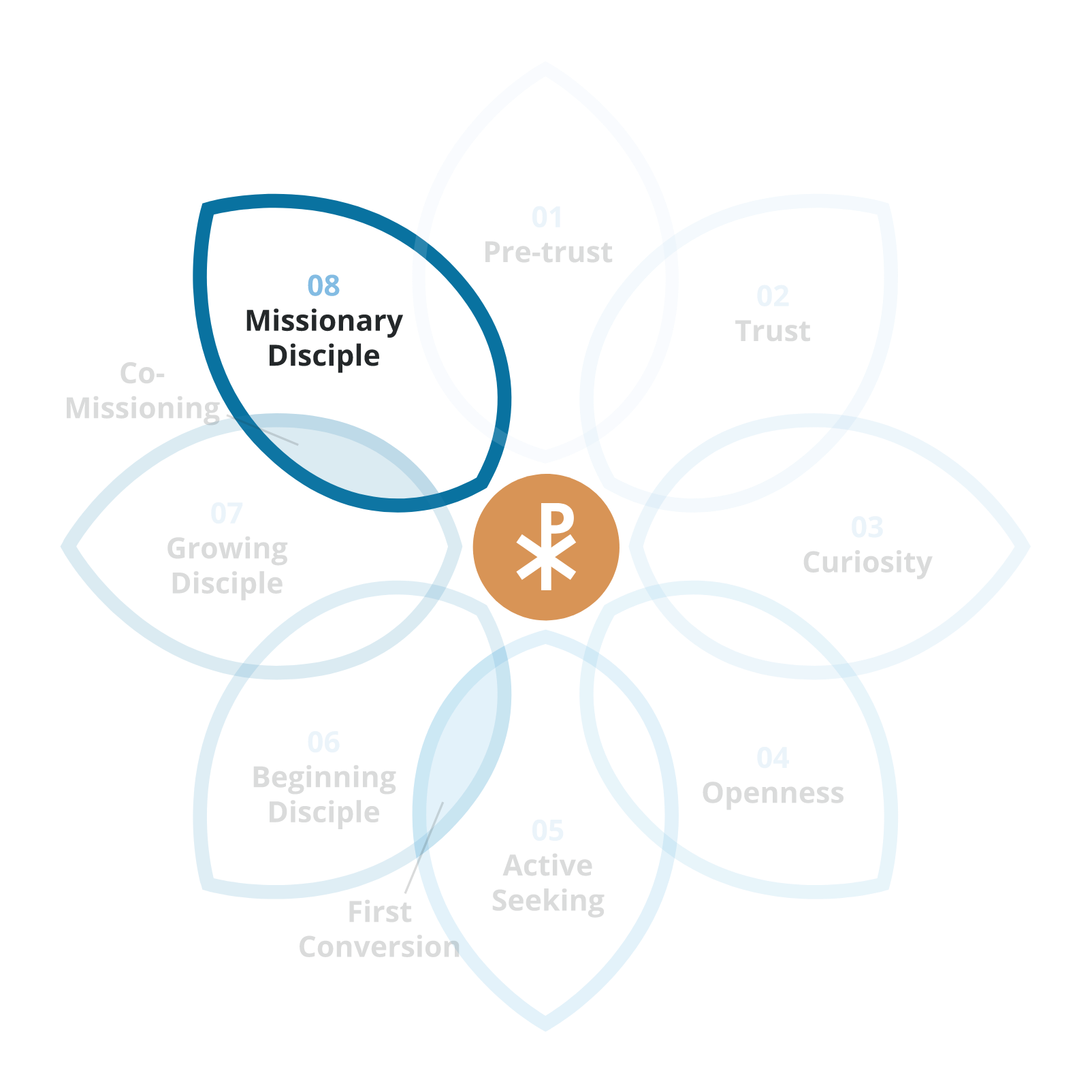The Foundational Principles of a Missionary Parish
A parish can provide intentional and effective ministry that creates disciples when its work is informed by two processes: the Process of Evangelization and the Process of Discipleship.



A parish can provide intentional and effective ministry that creates disciples when its work is informed by two processes: the Process of Evangelization and the Process of Discipleship.
These stages comprise the ecclesial process through which the Gospel is proclaimed, and the Church meets the needs of people where they are and facilitates progression along the journey of discipleship.
No matter where a person is along the discipleship path, there are two constants in our ministry to them: accompaniment and prayer.
The initial and still incomplete stage of evangelization that stimulates an interest in the faith and disposes one to receive the Gospel proclamation.
The proclamation of the saving message of who Jesus is and what He has done for us.
The stage that lays the basis for the Christian life of the followers of Jesus. It corresponds to the period of the catechumenate and purification & illumination in the catechumenal process.
In this stage, the baptized, assisted by multiple forms of ongoing education in the faith, seek to realize the desire of Christ: “Be perfect as your heavenly Father is perfect.”
This stage forms believers for mission, accompanying them in the maturation of attitudes of faith and making them aware that they are missionary disciples, called to participate actively in the proclamation of the Gospel and to make the Kingdom of God present in the world.
A catechesis that is simultaneously Good News and that highlights the truth, goodness, and beauty in everything we believe and do as Catholics in possession of a saving message.
These Thresholds and Decision Points mark the typical progression of the seeker’s journey from Pre-Trust to Missionary Discipleship.
Someone in this threshold either lacks or is unaware of any bridges of positive association with Jesus, a follower of Jesus, or something Christian.
Someone in this threshold has at least one positive association with something Christian.
Someone in this threshold has had his interest piqued regarding something Christian. He is suddenly aware of a new way to live and believe.
Someone in this threshold is able to admit to God and to themselves that they are open to the possibility of personal and spiritual change.
Someone in this threshold is on an overt, spiritual quest to resolve the final barriers that prevent a commitment to a personal relationship with Jesus.
This is the first Decision Point on the path of discipleship, the moment when a person says, “I believe in Jesus. I want a personal relationship with Him. I repent of my sin. I’m ready to live according to Jesus’ will for me.”
Someone in this threshold is new to the life of discipleship. He has decided for Jesus, but now what?
Someone in this threshold is ready to go deeper in his knowledge, spirituality, quest for holiness, and responsibility in the parish.
This is the second Decision Point on the path of discipleship. It is both a commissioning (a sending forth) and a co-missioning (a “being on mission with” the Church and the Holy Spirit).
Someone in this threshold is “on mission.” His focus is not so much on himself as it is on the soul of the other – and when his focus is on himself, it is so that he can better serve the other.
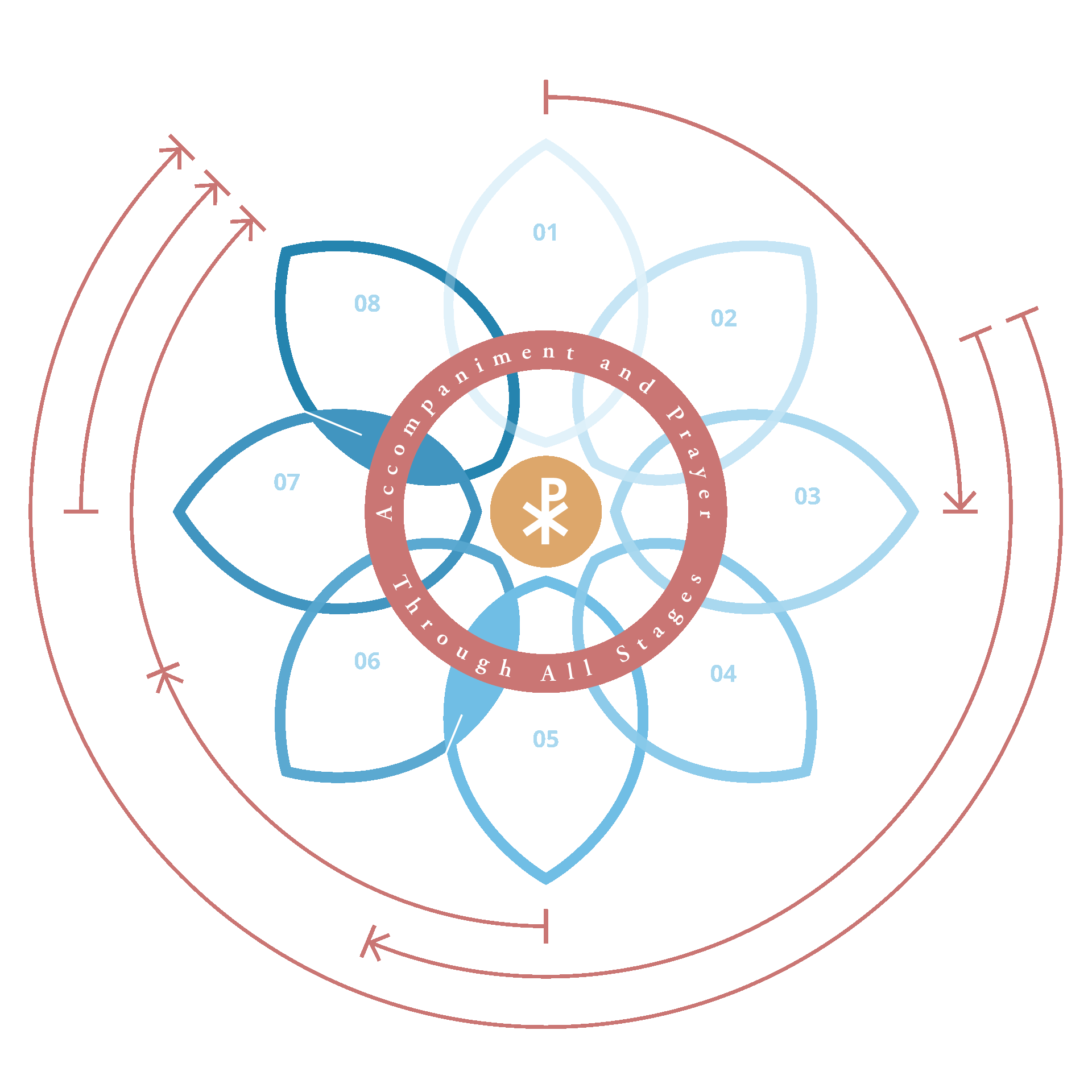
Deep Dive:
No matter where a person is along the discipleship path, there are two constants in our ministry to them: accompaniment and prayer.
Accompaniment is vital to the task of creating disciples:
“The present understanding of the formative dynamics of the person requires that intimate communion with Christ, already indicated in the existing Magisterium as the ultimate end of the catechetical initiative, should not only be identified as a goal but also brought about through a process of accompaniment.” (DC 3)
“The Church feels the duty of forming its catechists in the art of personal accompaniment, both by proposing to them the experience of being accompanied in order to grow in discipleship, and by enabling them and sending them to accompany their brothers.” (DC 135c)
“Accompaniment and growth in faith are necessary so that the adult may mature in that spiritual wisdom which illuminates and brings unity to the manifold experiences of his personal, family, and social life.” (DC 259)
As for prayer, teaching people how to pray is one of the primary tasks of catechesis (cf. DC 79, 86-87). But, not only is prayer something we are constantly teaching, modeling, and providing for people to experience, it is also something we constantly do for the people we serve. We pray for them always (and with them and over them as they are ready), and we ensure that other people are praying for them, too.
We also pray for our ministry efforts. In prayer, we discern if a particular initiative is what God wants. We pray that it will bear fruit. Within the context of prayer, we discern the initiative’s strengths and weaknesses.
“When catechesis is permeated by a climate of prayer, the assimilation of the entire Christian life reaches its summit.” (GDC 85) This is why an inner ring of accompaniment and prayer connects all the thresholds of the discipleship path.
To read more about the role of accompaniment in evangelization and discipleship, see the following:
To read more about the role of prayer in evangelization and discipleship, see the following:

Deep Dive:
To read more about the Pre-evangelization stage in the documents of the Church, see the following:
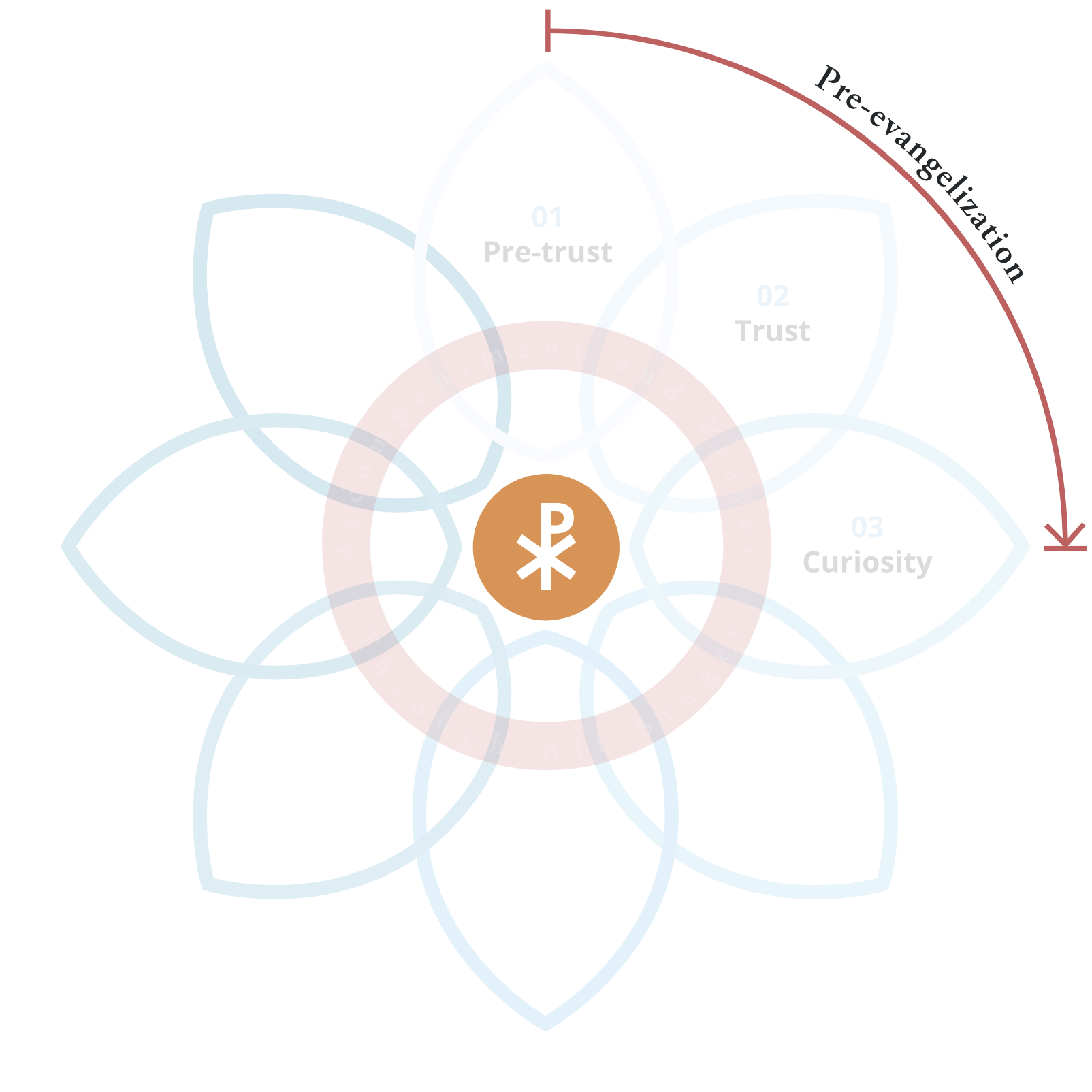
Deep Dive:
Also called the “initial” (CT 18-19, 21, 25), “primary” (GDC 51, 60-62), or “missionary proclamation” (GDC 26, 75, 222, 276-277), it is the proclamation of the Gospel, the saving message of who Jesus is and what He has done for us.
According to Pope Francis, “This first proclamation is called ‘first’ not because it exists at the beginning and can then be forgotten or replaced by other more important things. It is first in a qualitative sense because it is the principal proclamation, the one which we must hear again and again in different ways, the one which we must announce one way or another throughout the process of catechesis, at every level and moment.” (EG 164)
First Proclamation typically meets the needs of people in the thresholds of Curiosity, Openness, and Active Seeking.
To read more about the First Proclamation stage in the documents of the Church, see the following:
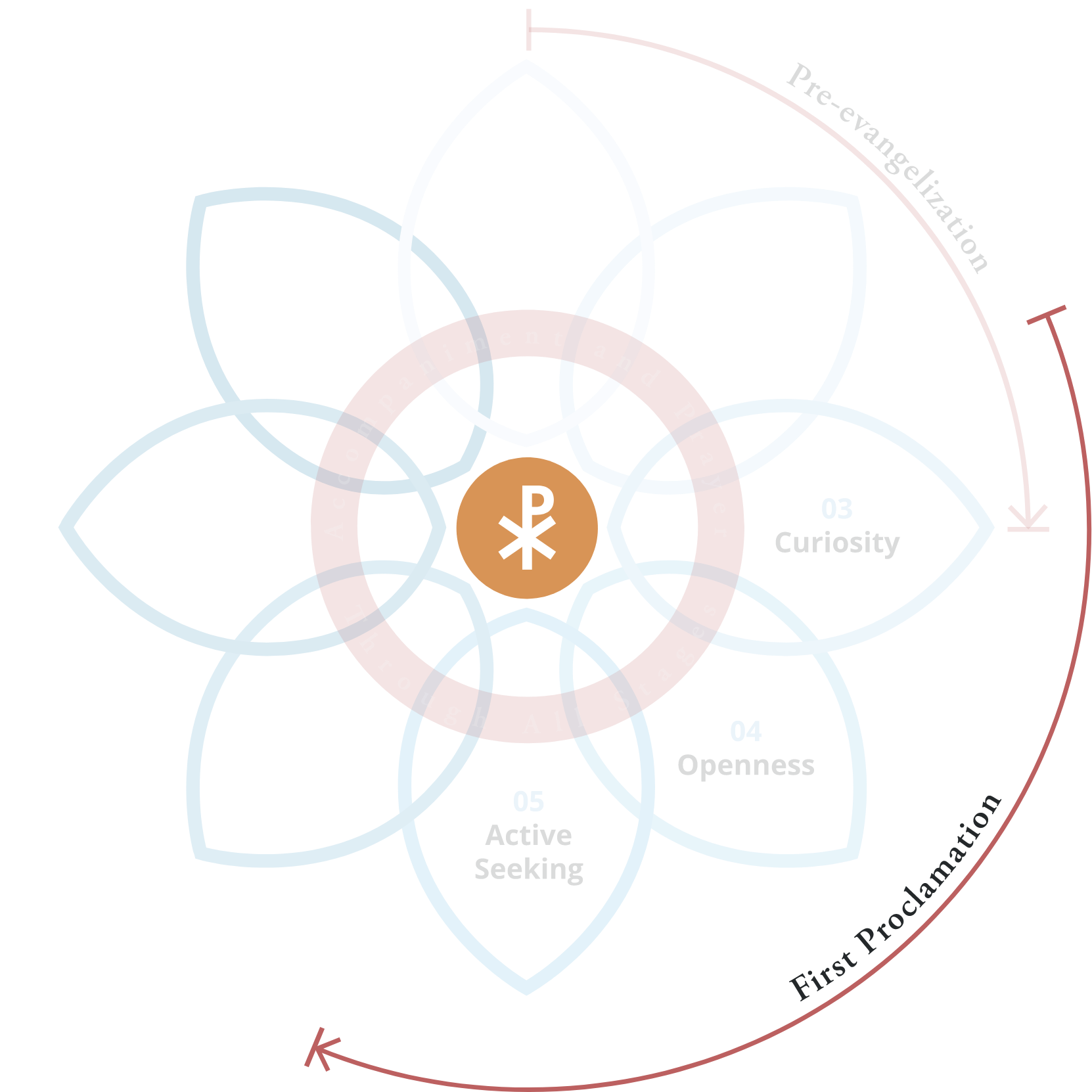
Deep Dive:
“Initiatory catechesis lays the basis for the Christian life of the followers of Jesus.” (GDC 69)
“Being comprehensive and systematic, [it] cannot be reduced to the circumstantial or the occasional. As it is formation for the Christian life it comprises but surpasses mere instruction. Being essential, it looks to what is ‘common’ for the Christian, without entering into disputed questions nor transforming itself into a form of theological investigation. Finally, being initiatory, it incorporates into the community, which lives, celebrates and bears witness to the faith. It fulfils, at once, initiatory, educational and instructional functions.” (GDC 68)
“This stage corresponds to the period of the catechumenate and to that of purification and illumination in the catechumenal program [the RCIA process].” (DC 34) It is the catechesis appropriate for Beginning Disciples (or at least those in Active Seeking).
Initiatory Catechesis typically meets the needs of people in the thresholds of Active Seeking and Beginning Disciple.
To read more about the Initiatory Catechesis stage in the documents of the Church, see the following:
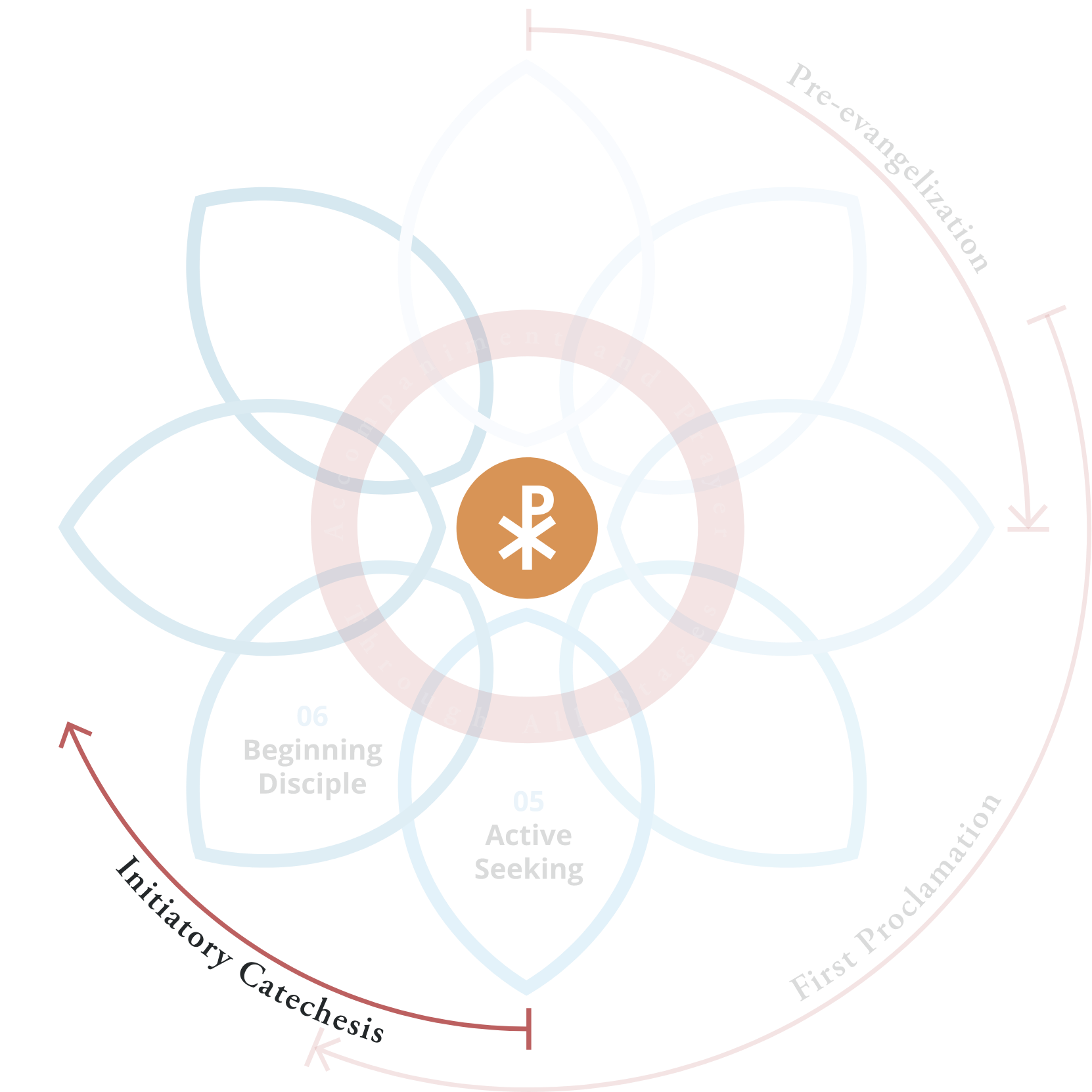
Deep Dive:
Perfective catechesis is “a systematic deepening of the Christian message by means of theological instruction, so as truly to educate in the faith, encourage growth in understanding of it and to equip the Christian for giving the reason for his hope in the present world.” (GDC 71). In this stage, “The baptized, … assisted by multiple forms of ongoing education in the faith, seek to realize the desire of Christ: ‘Be perfect as your heavenly Father is perfect.’” (GDC 56d)
This type of catechesis assists the Growing Disciple in his desire to delve deeper into the mysteries of the faith, the life of prayer, and the Christian community. The Directory for Catechesis calls this stage “pastoral action” (35). It corresponds with the Mystagogy stage of the RCIA process.
Perfective Catechesis typically meets the needs of people in the thresholds of Growing Disciple and Missionary Disciple.
To read more about the Perfective Catechesis stage in the documents of the Church, see the following:
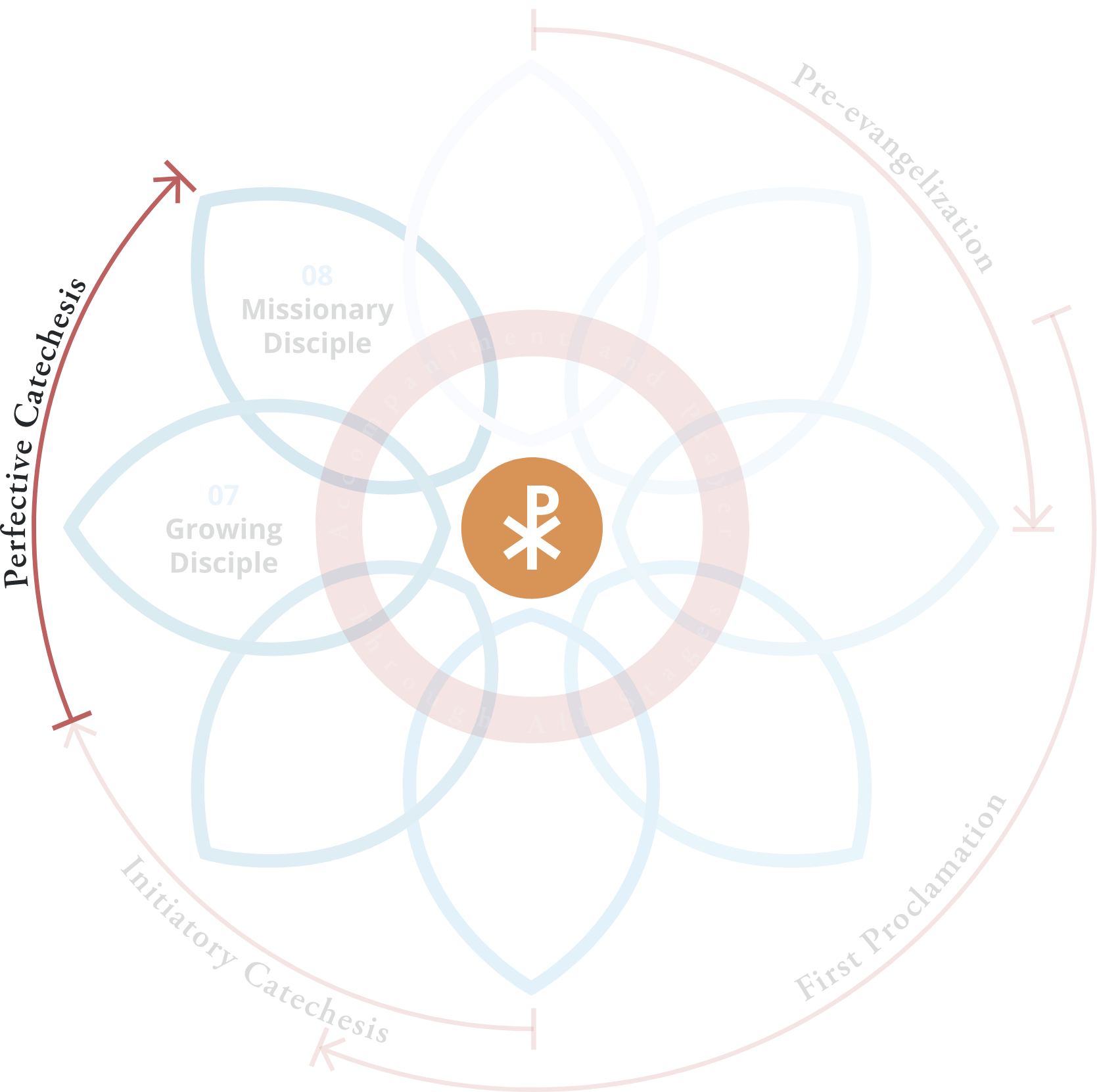
Deep Dive:
Missionary Initiation is one of the “other fundamental tasks of catechesis” (GDC 86):
“This seeks to equip the disciples of Jesus to be present as Christians in society through their professional, cultural and social lives. It also prepares them to lend their cooperation to the different ecclesial services, according to their proper vocation. This task of evangelization originates, for the lay faithful, in the sacraments of Christian initiation and in the secular character of their vocation.” (ibid.)
Catechesis in this stage “forms believers for mission, accompanying them in the maturation of attitudes of faith and making them aware that they are missionary disciples, called to participate actively in the proclamation of the Gospel and to make the Kingdom of God present in the world” (DC 50). When it is done well, “Christians will be eager to bear witness to their faith, to hand it on to their children, to make it known to others, and to serve the human community in every way.” (CT 24)
This stage in the Church’s catechetical activity should compel a Growing Disciple to the second Decision Point (“Commissioning”) and to becoming a Missionary Disciple.
To read more about the Missionary Initiation stage in the documents of the Church, see the following:
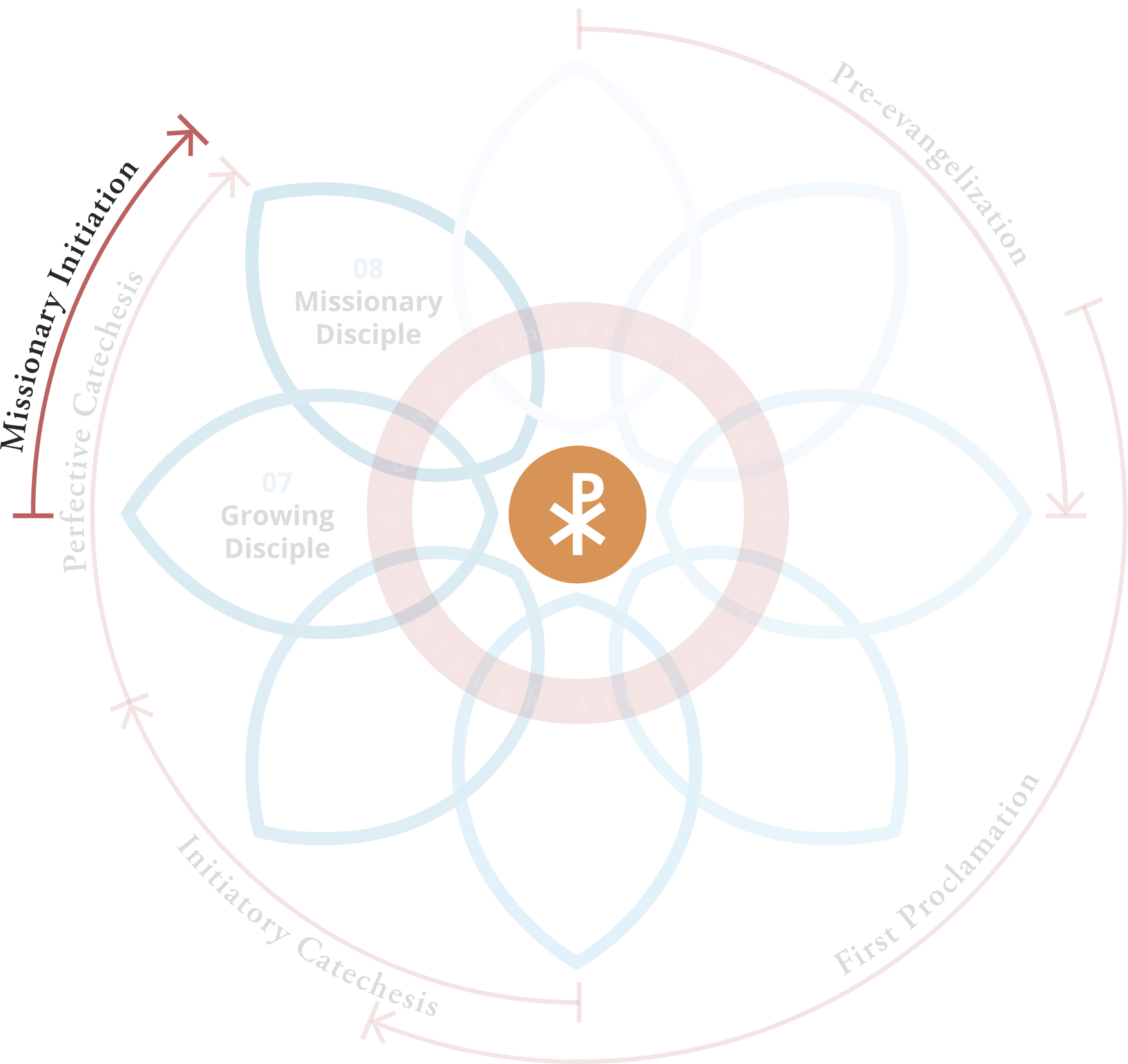
Deep Dive:
The word kerygma comes from the Greek word for “proclamation.” It is “simultaneously an act of proclamation and the content of the proclamation itself, which unveils the Gospel and makes it present.” (DC 58)
The urgency of this proclamation “brings into focus the need for a catechesis that in a consistent way can be called kerygmatic” (DC 57.). It “can therefore no longer be considered simply the first stage of faith, preliminary to catechesis, but rather the essential dimension of every moment of catechesis.” (ibid.)
Since the Gospel has permanent relevance in the lives of all people, as soon as catechesis becomes appropriate along the discipleship path, this catechesis should be kerygmatic.
To read more about the Kerygmatic Catechesis stage in the documents of the Church, see the following:
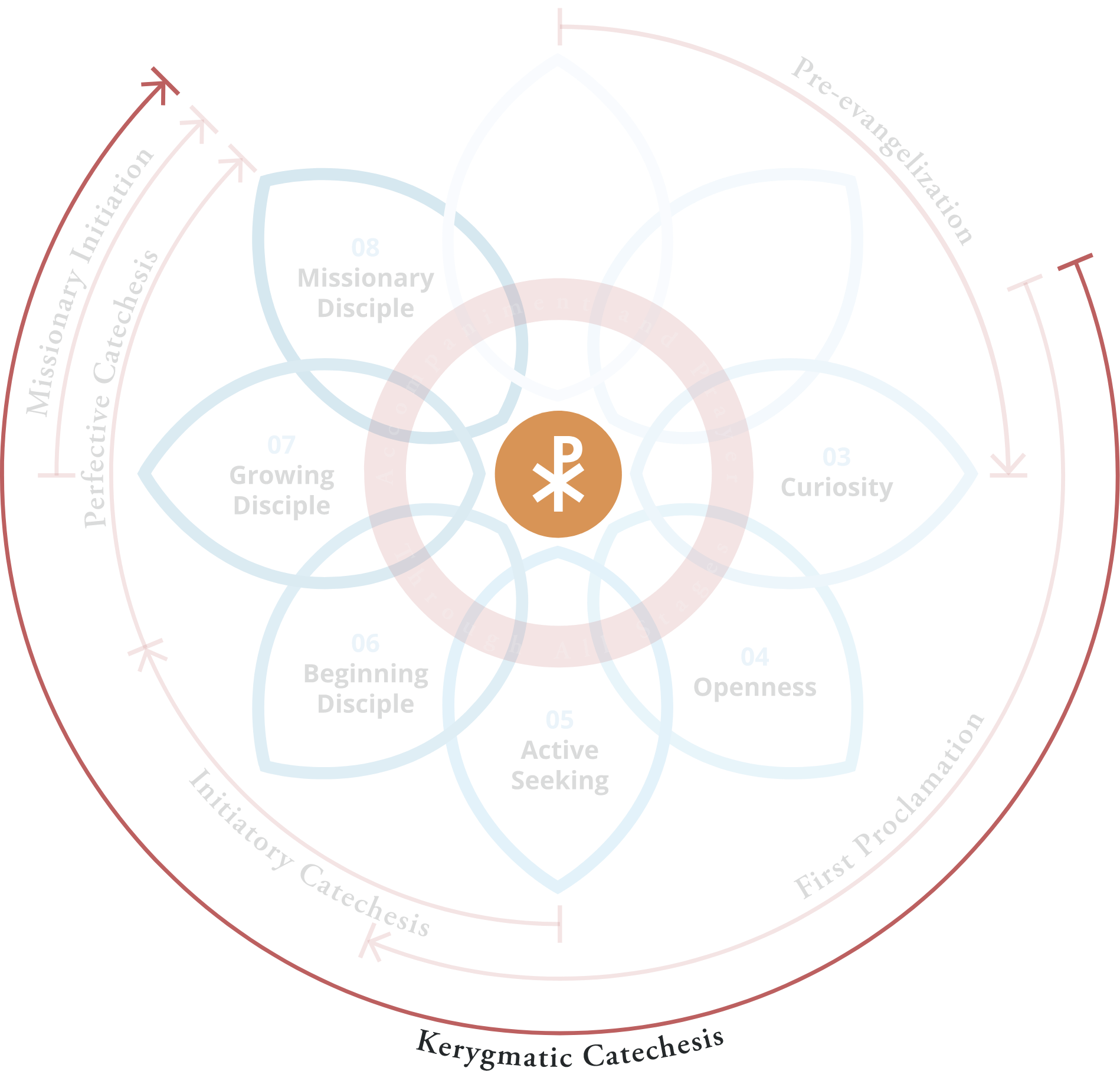
“Trust,” in this context, is defined as a positive association with Jesus, a follower of Jesus, or with something Christian. Trust exists as a bridge between you and the person you are befriending and serving.
Someone in the Pre-Trust threshold either has no associations with anything Christian, or all of their associations are negative. This is where people from modern, secular, industrialized settings typically begin. This is also the stage that many previously-trusting persons are thrust into by scandal and abuse in the Church.
Since they do not have bridges of positive association in place, they will most likely not be found on your parish grounds. And, as long they are in Pre-Trust, they will also not have any reason to listen to or take seriously anything you have to say about Jesus, faith, or spiritual things. At this point on their journey, you have not earned the right to be heard.
Someone in the Pre-Trust threshold needs:
Here are some possible ways to meet those needs:
Here are some possible ways to facilitate progression to the Trust threshold:
To read more about the Pre-trust threshold, see:
Note: Sherry does not specifically mention a “Pre-Trust” threshold, but she does discuss people who have not yet established bridges of positive association with Jesus, a Christian, or something Christian, and this threshold is where such people begin.

Someone in the Trust threshold has at least one positive association with Jesus, a follower of Jesus, or something Christian. This could be the crucifix that hung on the living room wall when the person was a child, the parish festival down the street that always offers the best barbecue, or the friendly Catholic who works in the next cubicle.
A positive association opens a person’s mind to the prospect of further positive associations with Christian things. The more positive associations a person has, the more apt they are to step closer toward Christianity.
Someone in the Trust threshold needs:
Here are some possible ways to meet those needs:
Here are some possible ways to facilitate progression to the Curiosity threshold:
To read more about the Trust threshold, see:

Someone in the Curiosity threshold is intrigued by or has had his interest piqued regarding something Christian. He is aware that there are other, possibly better or more fulfilling ways to live and believe, other than the way in which he is currently living and believing. He is aware … but he is not yet ready or even open to change.
He might nurture this curiosity by doing a quick Google search or posing questions to a trusted Christian friend. Sometimes, these questions will come across as offensive or antagonistic. He doesn’t usually mean to offend; he just has significant “-isms” to overcome (e.g., cynicism, antagonism, pessimism, relativism, etc.).
The search for answers during this threshold is generally surface-level and private. He’s not ready to out himself as someone who is on any kind of public, spiritual quest.
As this person approaches Openness, he might “try on” change to see what it feels like (e.g., by attending one weekday Mass and sitting in the back, or by watching EWTN when no one else is around).
Someone in the Curiosity threshold needs:
Here are some possible ways to meet those needs:
Here are some possible ways to facilitate progression to the Openness threshold:
To read more about the Curiosity threshold, see:
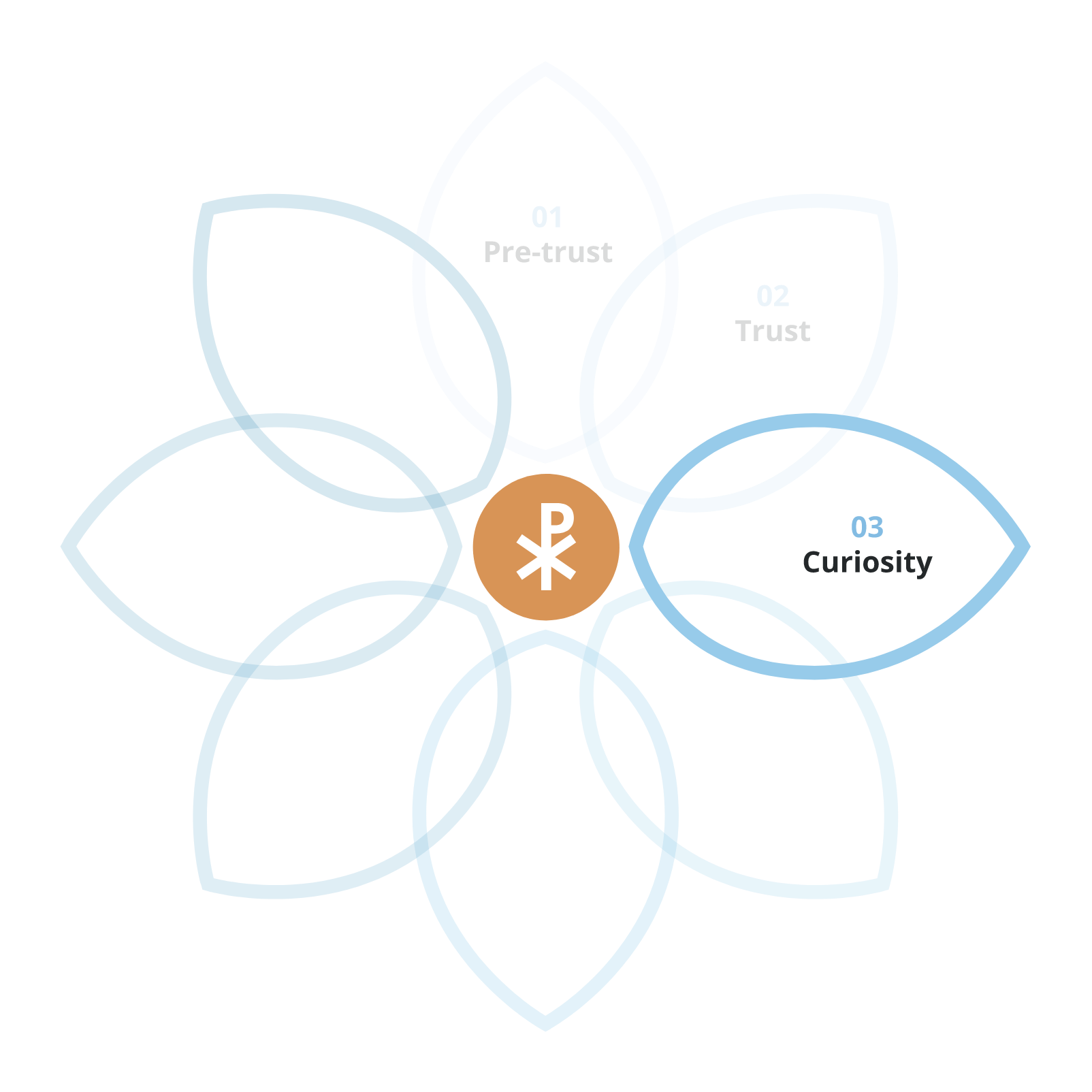
Someone in the Openness threshold has come to a place in their journey where they are able to admit to God and to themselves that they are open to the possibility of personal and spiritual change. They are not committed or ready to change, they are simply open to the possibility. In other words, they no longer reject it outright. Conversion is a potential option now.
This is the hardest threshold to move into because it requires lowering one’s defenses and overcoming many internal and external pressures. Someone in this stage may actually go back and forth between wanting change and being opposed to change. Sometimes they are excited, other times they feel vulnerable and afraid.
At this point, they have moved beyond most people in our parishes, which means that without some real intentional outreach, they may begin to feel that their spiritual needs are not being met. They may even leave the Catholic church for another church that they think will better meet those needs.
Someone in the Openness threshold needs:
Here are some possible ways to meet those needs:
Here are some possible ways to facilitate progression to the Active Seeking threshold:
To read more about the Curiosity threshold, see:
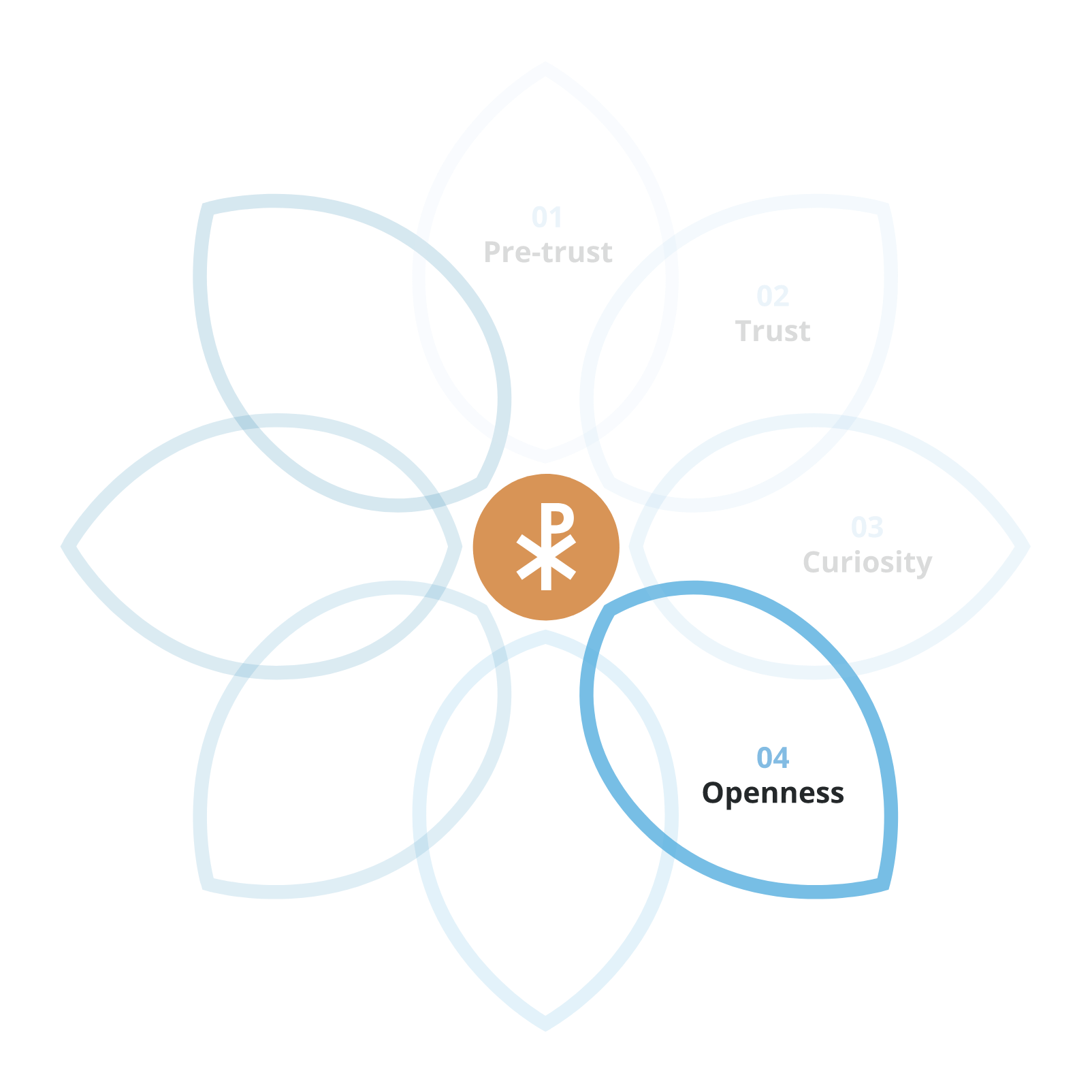
Someone in the Active Seeking threshold is now on an overt, spiritual quest. Their journey and their search for answers is no longer passive, superficial, or private. They are no longer speculating about interesting questions with no stake in the outcome. They feel an intense sense of urgency to resolve the final barriers and burning questions that stand in the way of the decision to go “all in” for Jesus in the midst of His Church.
They are now in “The Zone” (FID, pg. 171-172), the place of active wrestling with and serious contemplation of the following of Jesus. They are certain that a personal relationship with Jesus is possible, and this is what they are seeking. Note that this is with Jesus, not just “God” or a “Higher Power.” They are counting the cost of what it will take to follow Jesus of Nazareth as His disciple: What demands will discipleship make on my priorities, time, money, relationships, etc? Am I willing to accept those demands?
Their questions are also similar to the questions of those who “date with a purpose”: Is this person the One? Should I give my life to this One?
Someone in this threshold is now comfortable spending a lot of time with Christians. This person is also beginning to pray seriously, becoming aware of personal sin, and feeling the need for personal repentance.
Someone in the Active Seeking threshold needs:
Here are some possible ways to meet those needs:
Here are some possible ways to facilitate progression to First Conversion, the Decision Point that makes one a Beginning Disciple:
To read more about the Active Seeking threshold, see:
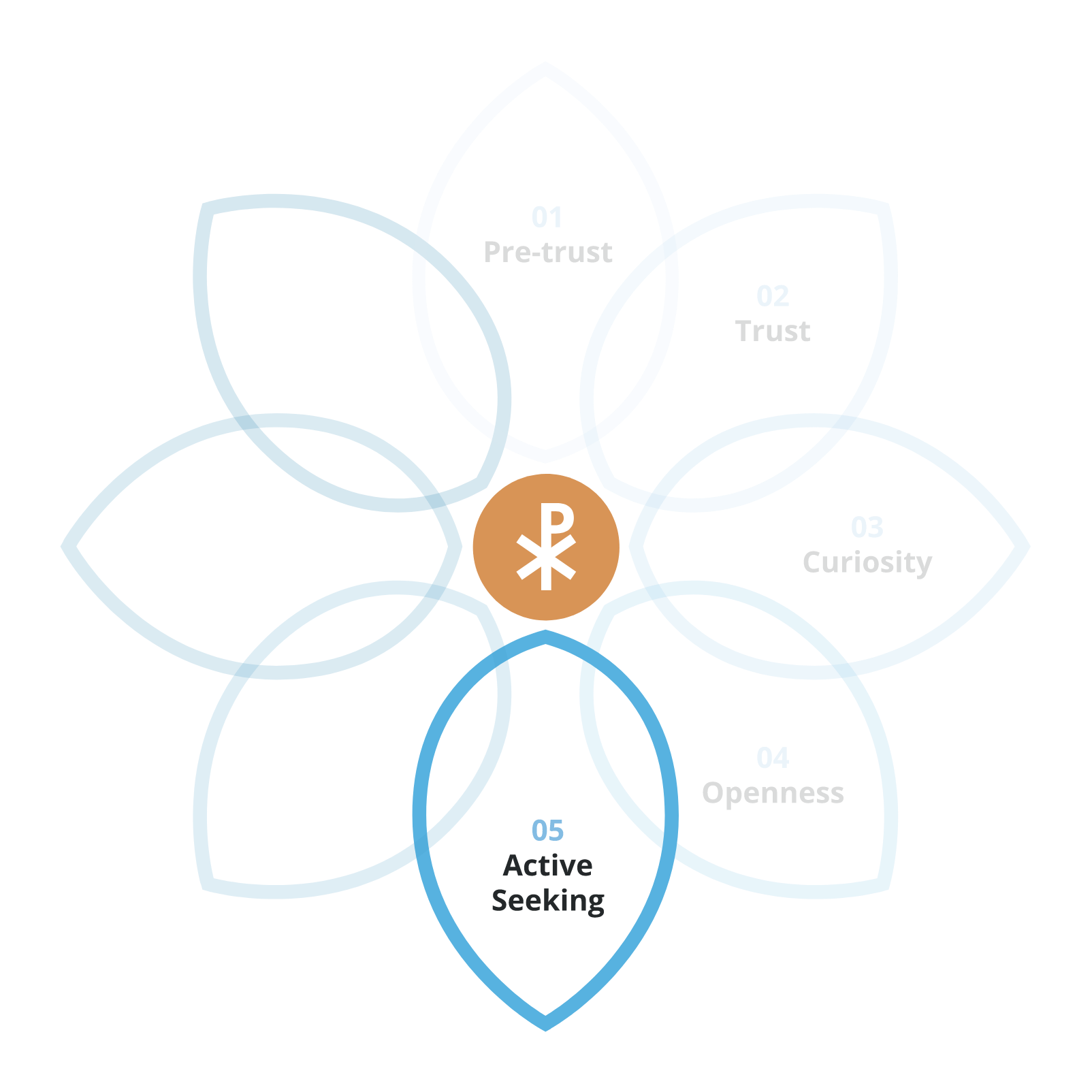
This is the first Decision Point on the path of discipleship. Of course, a person makes many decisions every day that impact his relationship with Jesus, but this one marks the critical moment when a person says, “I believe in Jesus. I want a personal relationship with Him. I repent of my sin. I’m ready to live according to Jesus’ will for me.” This is the decision to follow Jesus in the midst of His Church. Even life-long Catholics can experience a First Conversion. It is the kind of turning point in life that one never forgets.
This is called “First Conversion” to avoid implying that conversion only happens at this moment in the journey. Conversion does not only happen once, when we become disciples of Jesus. Instead, there is also the “Second Conversion”, which is the on-going process of overcoming sin, excelling in virtue and works of charity, and growing in holiness. This first decision marks the beginning of a lifetime of decisions to grow closer to Jesus.
As the Catechism of the Catholic Church explains:
1427 [. . .] Baptism is the principal place for the first and fundamental conversion. It is by faith in the Gospel and by Baptism (cf. Acts 2:38) that one renounces evil and gains salvation, that is, the forgiveness of all sins and the gift of new life.
1428 Christ’s call to conversion continues to resound in the lives of Christians. This second conversion is an uninterrupted task for the whole Church who, “clasping sinners to her bosom, [is] at once holy and always in need of purification, [and] follows constantly the path of penance and renewal.” (Lumen Gentium, no. 8, para. 3)[. . .]
Once the First Conversion has occurred, the person on the journey becomes a Beginning Disciple.
To read more about First Conversion, the first Decision Point, see:
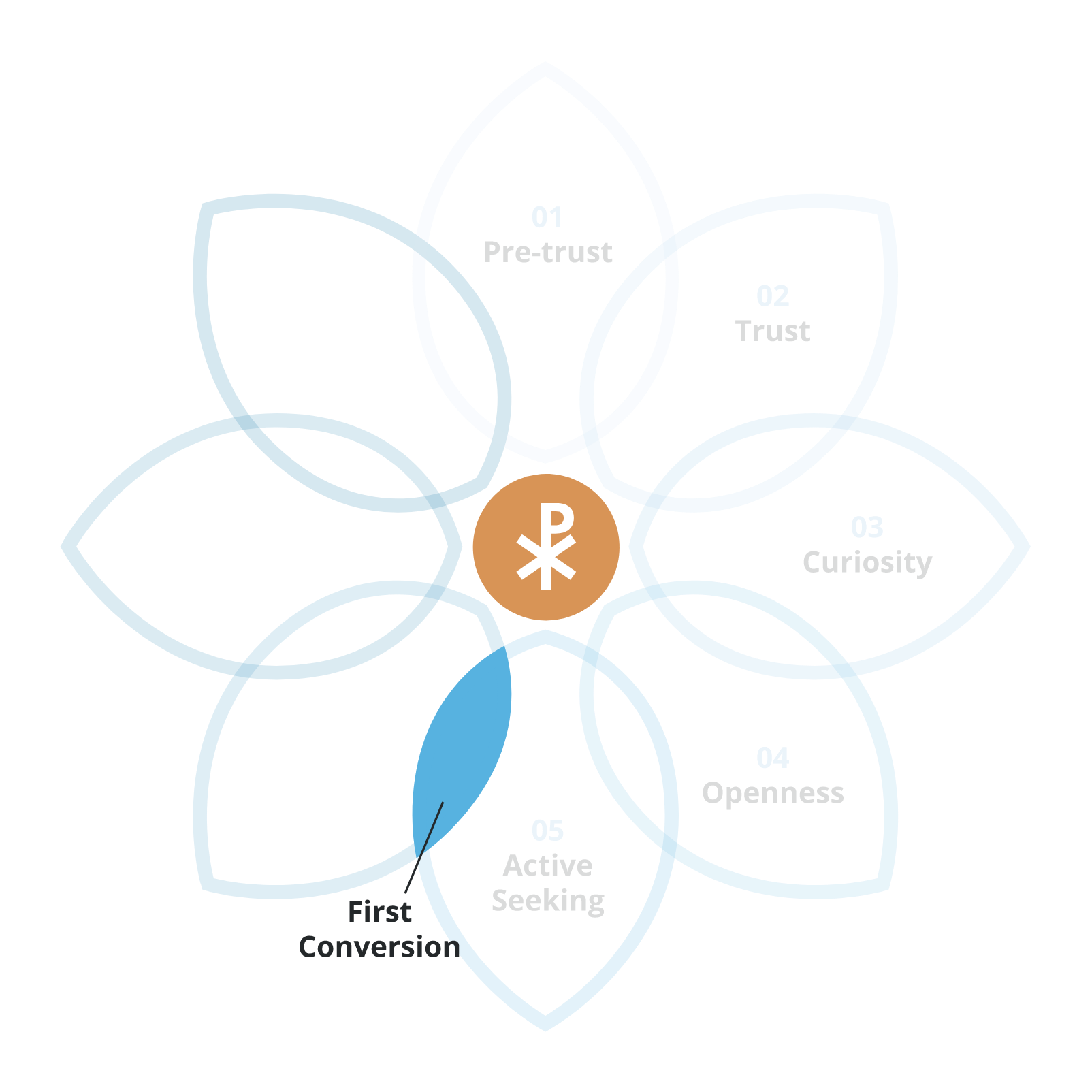
A Beginning Disciple is someone who is new to the life of discipleship. He has decided for Jesus, but now what? He may feel “on fire,” excited about Jesus, and ready to proclaim Him, but he either isn’t sure how or he goes about it in less-than-fruitful ways.
Often times, the Beginning Disciple has learned a great deal up to this point, but his learning was not systematic, nor did it organically develop. As a result, there are gaps and holes in his knowledge. He can sound like an expert in one area of the faith but know almost nothing about another area.
A Beginning Disciple might also have doubts or concerns about certain Catholic teachings or practices. He has decided for Jesus, but the ramifications of this for his Catholic faith still need to be worked out and realized.
The Beginning Disciple is also aware of his sin and is ready to live differently, but he may not have all the tools necessary to do this. For example, he may need help forming a daily prayer routine. He may not know distinctly Catholic ways of praying, such as the Rosary, a novena, or a Divine Mercy chaplet. He may need someone to accompany him to Confession or to Eucharistic Adoration, until he gets the hang of it.
He will participate in ministries and catechetical programs at the parish, but he typically feels like he has more to learn and experience before he can take a leadership role in these endeavors.
Finally, he wants to meet new people, especially Catholics his age who love their faith, but he’s not sure how. He’s looking for his “place” in the Church. Related to this, he’s also wondering what his role in the Church might be and how God is calling (and has equipped him) to serve.
Someone in the Beginning Disciple threshold needs:
Here are some possible ways to meet those needs:
Here are some possible ways to facilitate progression to the Growing Disciple threshold:
To read more about the Beginning Disciple threshold, see:
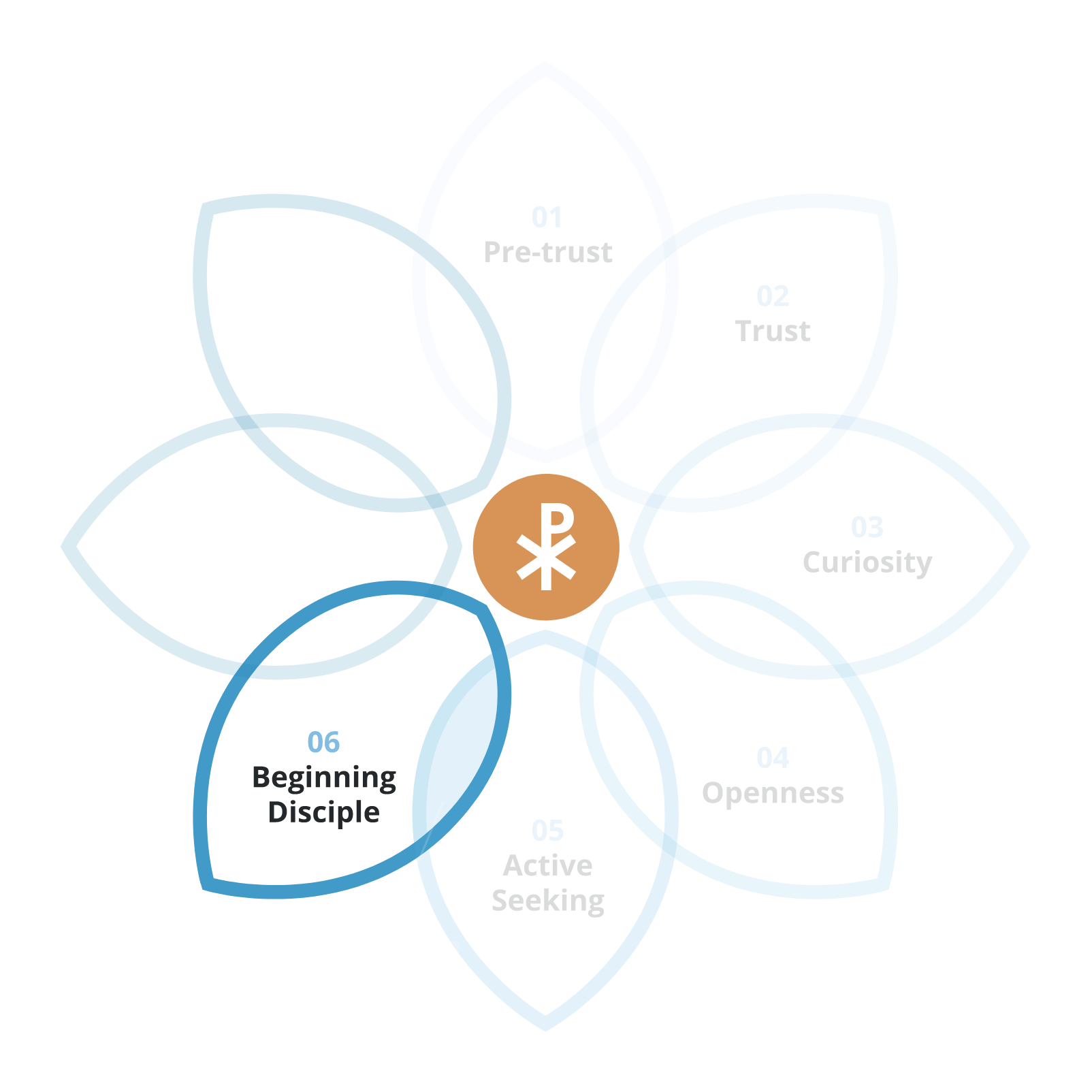
The Growing Disciple is someone who feels ready to take the next step. He’s ready for something more. This pertains both to his knowledge and his spirituality.
As to his knowledge, he’s read the introductory books that most people read. He knows the basic outline of the Bible. He’s familiar with the Catechism. He’s ready now to dive into the mysteries of the faith. For example, he may want to know more about the history of the Church. He may have a new interest in the early Church Fathers and their writings.
Regarding his spirituality, he’s ready for the deeper commitment that more involved ways of praying, overcoming sin, and increasing in holiness may require. For example, he may decide to abstain from meat on every Friday, instead of just the Fridays of Lent. He may choose one day a week to fast. He may begin praying novenas or foster a devotion to the “First Fridays” or “First Saturdays” of the month as days of reparation. He may begin going to Mass during the week as well as on Sunday, and going to Confession more regularly. He might sign up for a Holy Hour.
He is ready to go deeper, and he’s going there. But, at this threshold, his focus is still on his own personal journey of faith. This is okay, he needs to establish this good foundation for mission. He may want to proclaim the Gospel or share his faith with others, but he’s not sure how. A certain amount of fear and uncertainty may be present here, especially if he has never been accompanied himself or witnessed missionary discipleship.
Whereas a Beginning Disciple may be reluctant to take on positions of leadership in a parish, a Growing Disciple is ready to do so.
Undue zeal is an issue to address with people in this threshold. Sometimes a Growing Disciple can have trouble understanding and can even be impatient with people who aren’t as faithful or as knowledgeable as they are. These are the people who might drown a teaspoon of a question with a gallon of an answer. These are the people who can sometimes come across as judgmental to people from pre-discipleship thresholds.
Someone in the Growing Disciple threshold needs:
Here are some possible ways to meet those needs:
Here are some possible ways to facilitate progression to Commissioning, the Decision Point that makes one a Missionary Disciple:
To read more about the Growing Disciple threshold, see:
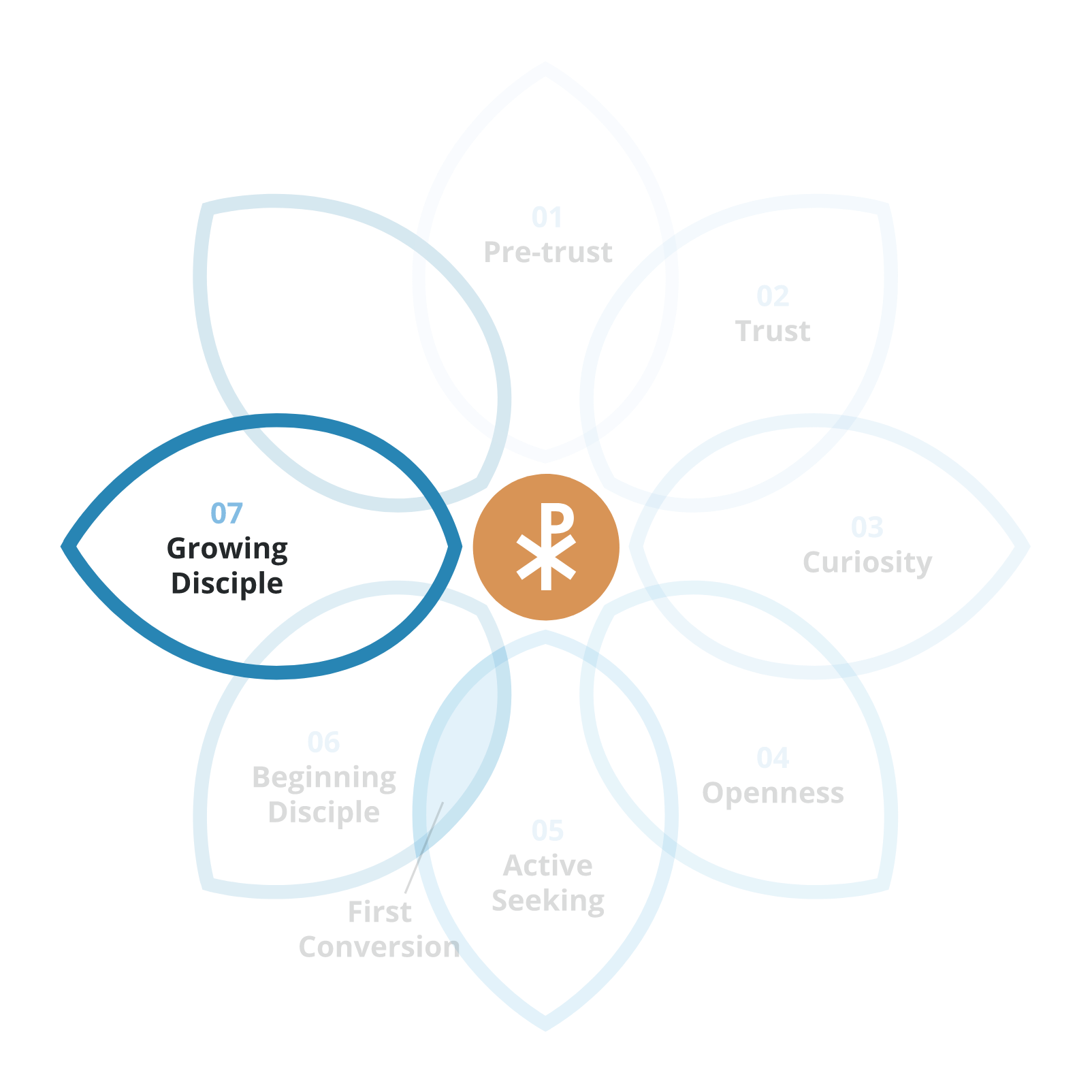
This is the second Decision Point on the path of discipleship. It is both a commissioning (a sending forth) and a co-missioning (a “being on mission with” the Church and the Holy Spirit).
Eventually, a Growing Disciple realizes that his focus and energy can no longer be just on his own growth and progression as a disciple. He comes to realize that with his Baptism comes both the call to evangelize and the gifts necessary to evangelize in his own way. Even more than this, he realizes that this call is something he can no longer ignore. “Necessity is laid upon me. Woe to me if I do not preach the gospel!” (1 Cor 9:16).
There are few processes or rites in the Church for commissioning a disciple in any formal kind of way. Confirmation can be one, although it is extremely difficult, since Confirmation typically takes place on a fixed date and the Holy Spirit doesn’t always work according to our timelines. The RCIA process can be one. Institution into the Ministry of the Catechist can be one. Perhaps the parish or diocese could create other ways to formally commission disciples.
Typically, though, the decision takes place interiorly. The Growing Disciple just decides, “I’m going to listen to the promptings on my heart. I’m going to be a witness. I can’t keep my faith to myself anymore.” His experience is that of the prophet Jeremiah:
“If I say, ‘I will not mention him or speak any more in his name,’ there is in my heart as it were a burning fire shut up in my bones, and I am weary with holding it in and I cannot.” (Jer 20:9)
Once a person decides to live his faith radically, boldly, and in service to the other, then that person becomes a Missionary Disciple.
To read more about Commissioning, the second Decision Point, see:
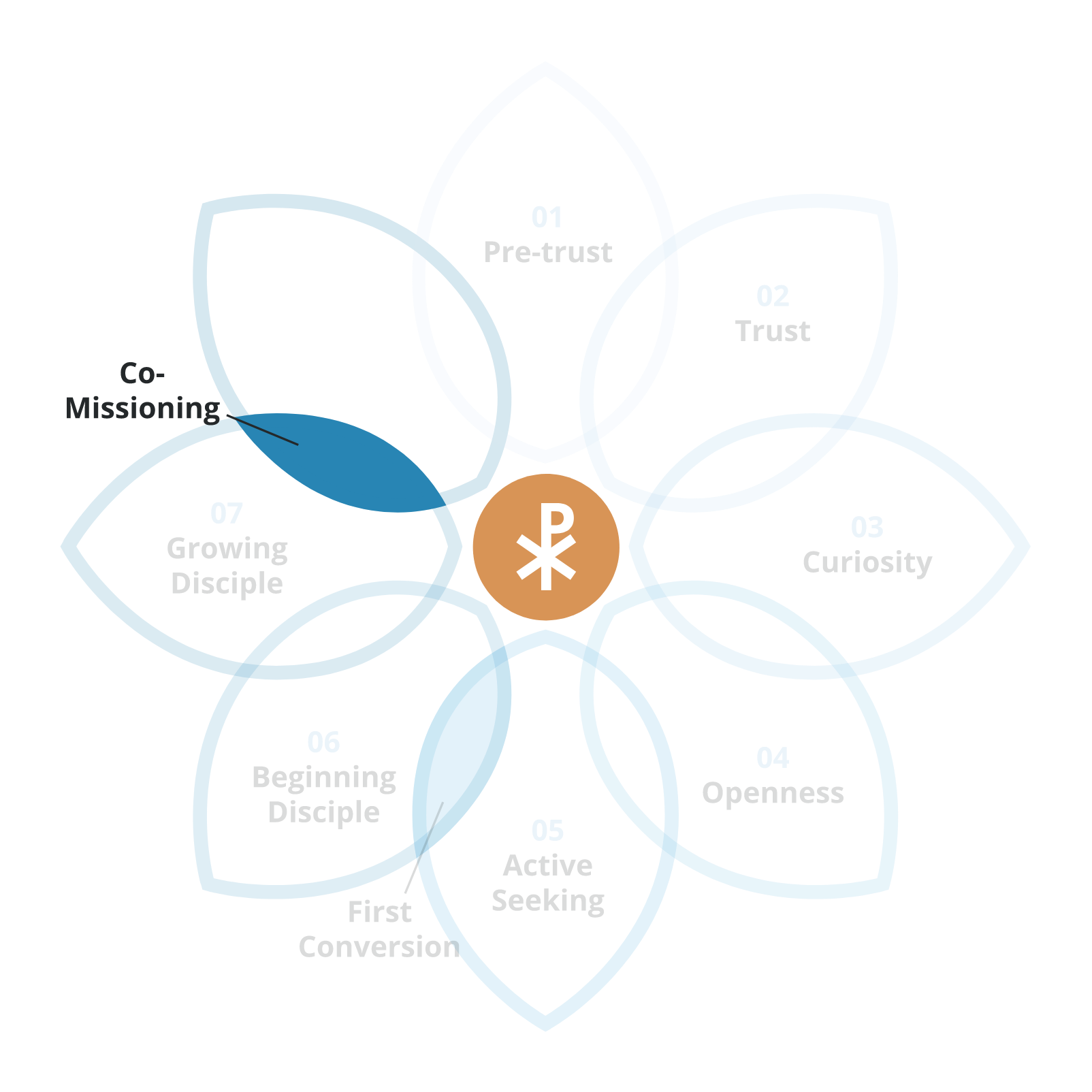
A Missionary Disciple is a disciple who is “on mission.” His focus is not primarily so much on himself as it is on the soul of the other – and when his focus is on himself, it is so that he can better serve the other. That could be friends and family, but also neighbors, co-workers, parishioners, and even complete strangers. He has learned some basic strategies for reaching out to others, sharing his faith, and proclaiming the Gospel, and he is eager to learn even more ways to do this.
He prays regularly, but he is also open to praying with and over other people. He knows Jesus, and especially how Jesus has changed his life, and he’s eager to tell that story. He wants to help people, answer their questions, make them feel welcome, and be a guide to them. He may even have a handful of people that he is intentionally walking with, praying with, sharing his life with. He checks in on them every now and then to see how they are doing, and he makes himself available if they need to talk.
He is involved in the parish, but his missionary activity is not confined to the parish. In his work, in his family time, even when he’s going about the mundane activities of daily life, he is radiating Christ or at least striving to. He knows what his gifts are and he is eager to use them.
He’s obviously not perfect. He’s still working to overcome sin. He doesn’t seize every moment. He doesn’t always make the right decisions. But he loves Jesus, he loves his neighbor, he’s trying his best, and he wants to help other people to try their best, too.
Someone in the Missionary Disciple threshold needs:
Here are some possible ways to meet those needs:
Here are some possible ways to equip and sustain Missionary Disciples:
To read more about the Missionary Disciple threshold, see:
